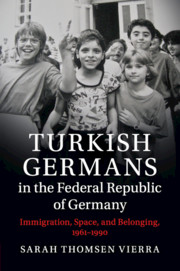Book contents
- Turkish Germans in the Federal Republic of Germany
- Publications of the German Historical Institute
- Turkish Germans in the Federal Republic of Germany
- Copyright page
- Contents
- Figures
- Maps
- Acknowledgments
- Abbreviations
- Introduction
- 1 Settling In at Work
- 2 At Home in Almanya
- 3 Around the Neighborhood
- 4 Learning to Belong
- 5 Making Space for Religion
- 6 Belonging in Reunified Germany
- Conclusion
- Appendix
- Bibliography
- Index
- References
Bibliography
Published online by Cambridge University Press: 31 October 2018
- Turkish Germans in the Federal Republic of Germany
- Publications of the German Historical Institute
- Turkish Germans in the Federal Republic of Germany
- Copyright page
- Contents
- Figures
- Maps
- Acknowledgments
- Abbreviations
- Introduction
- 1 Settling In at Work
- 2 At Home in Almanya
- 3 Around the Neighborhood
- 4 Learning to Belong
- 5 Making Space for Religion
- 6 Belonging in Reunified Germany
- Conclusion
- Appendix
- Bibliography
- Index
- References
Summary

- Type
- Chapter
- Information
- Turkish Germans in the Federal Republic of GermanyImmigration, Space, and Belonging, 1961–1990, pp. 243 - 258Publisher: Cambridge University PressPrint publication year: 2018



